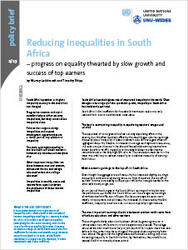Policy Brief
Reducing inequalities in South Africa
Progress on equality thwarted by slow growth and success of top earners
South Africa has the highest rate of measured inequality in the world. Often thought to be a legacy of the apartheid system, inequality in South Africa has stubbornly persisted.
South Africa’s position as highest inequality country in the world has not changed
Progressive taxation and social transfers help to offset existing inequalities, but they cannot solve inequality alone
Policies that target earnings inequalities and expand employment opportunities are a crucial part of any solution to inequality
The main earnings inequality in the South African labour market is between top incomes and everyone else
Other important inequalities are those between men and women, whites and blacks, and college-educated versus non-college educated.
Inequalities in wealth, assets and income from capital underpin the persistence of these income inequalitie
South Africa’s Gini coefficient for household income per capita was only reduced from 0.68 to 0.66 between 1993–2014.
The key to overcoming inequality is equalizing workers’ wages and salaries
The expansion of social grants has had a strong equalizing effect in the country, but this effect has been offset by the much bigger role that earnings inequality plays. Inequality in labour income has by far the largest effect on aggregate inequality. Despite an increase in average earnings over 1993–2014, and even a major increase in the share of households earning income from labour (60.5% to 72.6%), inequality in household labour market income remained stuck at the very high Gini of 0.73. The conclusion must be that the most impactful way to redress inequality is to address inequality of earnings from labour.
Most economic gains go to the top 5% in South Africa
Even though the aggregate rate of inequality has improved slightly, earnings inequality has deteriorated during 2003–15. Over this period, the top 5% of earners’ income increased by 5.1% per year while the average income for the other 95% mostly stagnated.
An analysis of the changes in the South African earnings distribution over the period 2001–14 found that South Africa saw the average real earnings of workers rise from R5,740 to R7,951. But because wage increases went mostly to top earners, overall inequality increased. As measured by the Gini coefficient, inequality rose from 0.55 to 0.63 an atypically large increase.
The most important earnings divide is between workers with some form of tertiary education and other workers
The earnings divide by education has been driven by growing returns to tertiary education, while returns to work experience plateaued. The college educated are now much more likely to join South Africa’s upper class than ever before. At the same time, the earnings of the upper class are growing faster than others’. The gains for the highly educated had such a strong impact on increasing inequality in South Africa that, by themselves, they would have caused the Gini to move by eleven points.
 Progress on gender and racial equality needs to continue
Progress on gender and racial equality needs to continue
The increase in labour inequality was offset somewhat by major gains to equality from progressive taxation, increases in social protection, and improvements in racial and gender-based equality in the labour market.
The earnings divide between Whites and Africans1 fell from 67% to 57% and the gap between what men and women earn also fell, by 5 percentage points. Nonetheless, these demographic divides are still so large that they continue to decrease earnings equality in South Africa, causing 3.5 percentage point (racial inequality) and 0.5 percentage point (gender inequality) net increases in earnings inequality. Continuing to improve racial and gender earnings equality is therefore crucial to improving overall levels of equality in South Africa.
The middle class needs to be bigger and more stable
The tax and transfer system in South Africa is among the most progressive of the middle-income countries, but not progressive enough to meaningfully counteract labour market inequality. The roll-out of new social grants, improvements in the progressivity of taxation policy, and new laws protecting the minimum wages of the lowest earners have all kept South African inequality from growing further, but they have not been enough to overcome the country’s rising earnings inequality.
One of the biggest reasons that earnings inequality did not increase further has been the loss of income and employment stability to experienced workers as the economy undergoes structural changes. This phenomenon does not represent real gains to long-term equality but rather a convergence of wages in the middle of the distribution helped along by a major decrease in unionization, which narrows the gap in earnings between non-unionized and unionized workers. This phenomenon offsetts increases in the inequality measure by decreasing real wages in the middle rather than by raising wages at the bottom of the distribution.
More research needed on wealth, generational, and intersectional inequalities
Both the labour market and the capital market have worked in ways that strongly favoured those at the top end of the earning distribution. Investment income is an unimportant part of most South African households’ overall income, measuring just 4.5% on average, but it likely has important unexplored effects for the incomes of top earners. The South African Gini for investment income was 0.98 in 2014, the most recent year calculated, meaning that investment income plays a major role in top incomes. In 2014, the bottom 77% of the distribution received no income from this source, which was still a major improvement from 2008 when only 6% of the population received investment income.
South Africa should continue to support and expand policies that improve gender and racial inequality
Labour market policies are central here, with a need to equalize both access to employment as well as the type of work
Focus should be put on improving the long-term career trajectories of South Africa’s workers, particularly those in the bottom 95% of the distribution
South Africa should continue to protect the system of social grants and, when possible, expand their scope
Measures should be explored to improve the efficiency of service delivery in the system of social grants in South Africa to maximize the gains from existing resources
Democratizing ownership in South Africa is an important long-term equalizer but it will require some equalization of assets and wealth in order to encourage households to save and invest
More research needs to be done on wealth inequality, age-based inequalities, intersectional inequalities, and generational inequalities to understand how the lifetime earnings and investments of different groups might impact overall levels of inequality.
 Join the network
Join the network